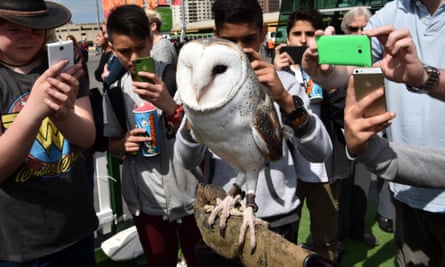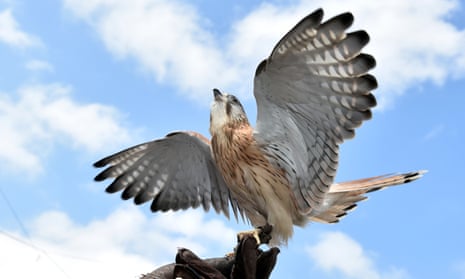Gazing at large numbers of birds darting overhead may not be ideal for people with Hitchcockian fears but the steady emptying of Australian skies of some species is getting twitchers a little, well, twitchy.
The annual Aussie back yard bird count swooped into action in Melbourne’s Federation Square on Tuesday morning with the expectation that some worrying declines in some of Australia’s most common birds will be confirmed.
BirdLife Australia’s state of Australia’s birds report, released in July, found that well-known species such as the magpie, kookaburra, lorikeet and willie wagtail were dropping in numbers across large parts of the country.
The backyard count, which encourages people to step out of their house for 20 minutes to count birds, is a less rigorous exercise. Last year’s effort included reports of penguins in the Murray river, after all.
But the count is expected to highlight the level of concern over Australia’s birds that recently prompted a federal government plan to save some of the most threatened of our feathered friends, including the helmeted honeyeater and the night parrot.
The concrete-slathered Federation Square may not be a birders’ paradise but even here a total of seven species were spotted in 20 minutes, including – of course – the rock dove, or pigeon.
The highlight was probably two bright flashes identified as lorikeets by the experts at BirdLife Australia as handlers fed two celebrity birds – Min Min the one-eyed barn owl and Kevy the nankeen kestrel – perched on gloves. Children happily scribbled colours into outlines of hawks and eagles on paper.

“I’ve seen twitchers from England get off the plane and burst into tears at the sight of a lorikeet. They are like someone paintballed the sky,” said Sean Dooley, editor of Australian Birdlife magazine, whose eye often wanders skywards during conversation. “We have amazing birds in Australia, and if we lose them we lose one of the few connections with nature we have in our urban-based society.
“It’s all very well talking about threatened species in exotic jungle national parks but that’s not where people experience nature. People become conservationists from seeing birds in their back yards or at school.
“We only seem to notice declines when we’ve got so few animals left that we can name them, like Benjamin the Tasmanian tiger or whatever, but we should be just as concerned that we’ve lost 50% of our laughing kookaburras in the past 15 years.”
Common back yard birds are not the only winged beasts under pressure. Some birds of prey are in trouble, particularly in Australia’s arid centre. Elsewhere, the little eagle is declining in New South Wales, possibly because of the poison used to kill its favoured prey, rabbits.
“We see birds injured by barbed wire, hit by cars, poisoned – all human interventions,” said Martin Scuffins, from the Leigh Valley hawk and owl sanctuary, which is near the Victorian city of Ballarat.
Scuffins has Kevy perched on his hand. “She’s the only kestrel I know who enjoys eating mealworms,” Scuffins said gleefully, shoving more of the worms into Kevy’s beaked maw.
The cause of the decline of common species is not entirely clear and varies by location. For example, magpie numbers have slumped 31% in eastern Australia, but not in Tasmania.
More research is required but it is clear that land clearing, pesticide use and the introduction of feral species has hardly aided most bird species. Climate change is becoming an increasingly pertinent factor; Dooley said migration and feeding patterns were changing because of altering temperatures.
“We are seeing birds responding quickly to climate change,” he said. “They are ahead of the game and certainly ahead of the conservative commentariat.
“Where you have a concerted effort on the ground you can turn things around but threatened species are the outward symptom of a system in crisis. You have to give the government marks for paying attention to threatened species but there’s no point putting band-aids on gaping wounds.
“We need to talk about land clearing, feral species, changed fire regimes. We’ll end up with far more threatened bird species if we don’t tackle these big things.”
More than 800,000 individual birds across 500 species were spotted in last year’s back yard count. BirdLife Australia hopes this year’s number-taking exercise, running from 19 to 25 October, will break the 1m mark. To take part, click here.

Comments (…)
Sign in or create your Guardian account to join the discussion